With all the buzz around AI agents and the results they’re already delivering, business executives are realizing that AI agents truly transform how enterprises operate. Now, after understanding their real potential, leaders are exploring adoption strategies and, most importantly, asking the question at the top of every 2025 digital agenda: how much does it really cost to build and scale an AI agent?
There are multiple reasons businesses are integrating AI agents into their digital strategy. Beyond handling basic customer queries, AI agents are becoming central to enterprise operations, enhancing customer engagement, streamlining workflows across departments, and opening new avenues for revenue growth. The potential is enormous, but so are the stakes: underestimating costs or complexity can derail budgets, delay timelines, and stall strategic initiatives.
You may have seen headline estimates ranging from $10K to $100, depending on complexity. But these numbers rarely tell the full story. True AI agent development costs encompass engineering, infrastructure, system integrations, data pipelines, governance, compliance, training, and ongoing maintenance, the critical elements that determine whether an investment scales effectively or stalls.
When executed right, AI agents become a force multiplier, reducing operational costs, unlocking growth, and strengthening competitive advantage. When executed poorly, budgets spiral, timelines stretch, and strategic momentum is lost.
This guide helps decision-makers understand the 2025 AI agent cost structure, identify hidden cost drivers, and apply strategies to maximize ROI, ensuring every investment delivers measurable and sustainable value.
Types of AI agents and their cost factors
Before evaluating the cost of AI agent development, enterprises must first understand the different types of AI agents available on the market. Each agent type is designed with distinct functionality, development requirements, and AI model complexity, all of which influence development costs, scalability, integration, and ongoing maintenance.
By recognizing these differences upfront, leaders can align AI initiatives with business objectives, anticipate hidden costs, and make informed decisions about where to invest.
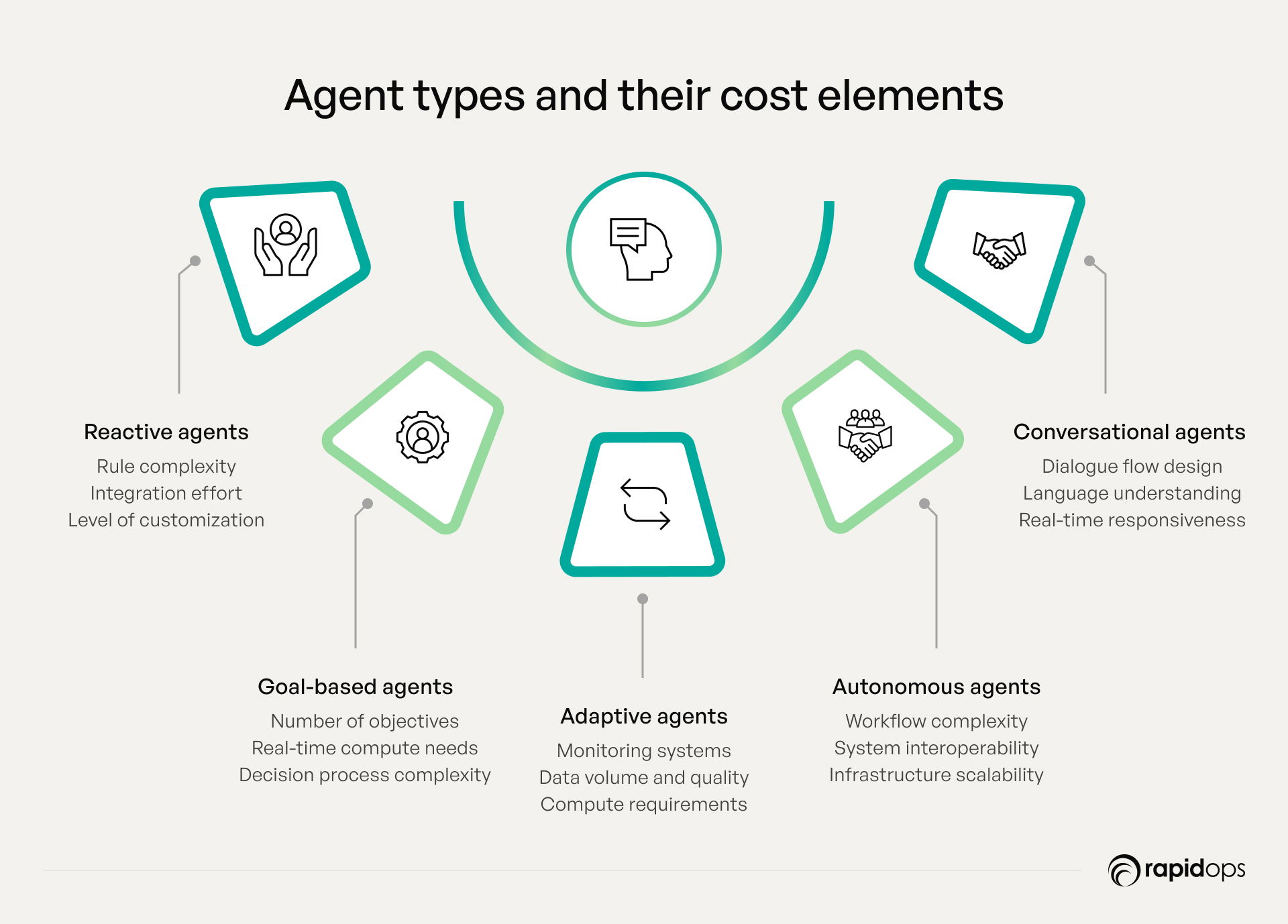
Reactive agents
Reactive agents are the simplest form of AI, designed to respond immediately to inputs without storing or learning from past interactions. Their development primarily involves defining rule-based logic, designing deterministic workflows, and integrating with relevant enterprise systems. Cost factors include the number and complexity of rules, the level of customization, and the effort required for system integration. While these agents are cost-effective and quick to deploy, their limited adaptability restricts scalability, requiring enterprises to plan for potential upgrades as business needs evolve.
Goal-based agents
Goal-based agents operate with purpose-driven decision-making, selecting actions to achieve defined objectives rather than merely reacting. Their development involves decision algorithms, optimization models, and scenario evaluation frameworks. Costs increase with the complexity of decision-making processes, the number of objectives managed, and the computational resources needed for real-time evaluations. These agents bridge basic automation and strategic operational goals, making them critical for aligning AI initiatives with business KPIs.
Adaptive (Learning) agents
Adaptive agents utilize machine learning (ML) models and feedback loops to learn from both historical and real-time data, thereby continuously improving their performance. Development involves data preprocessing, feature engineering, model training, hyperparameter tuning, and deployment pipelines. Costs are influenced by data volume and quality, compute requirements, model retraining frequency, and monitoring systems to ensure consistent performance. Adaptive agents enable enterprises to scale intelligence across operations but require significant investment in both AI/ML expertise and infrastructure.
Autonomous agents
Autonomous agents can independently execute end-to-end workflows, integrating multiple AI models and enterprise systems without human oversight. Development requires multi-agent orchestration, robust AI architectures, and governance frameworks to manage compliance and operational risk. Costs are driven by workflow complexity, system interoperability, infrastructure scalability, and safety mechanisms to prevent operational errors. These agents represent the highest tier of AI sophistication, capable of transforming enterprise efficiency when deployed with careful planning and implementation.
Conversational agents
Conversational agents interact with users using natural language processing (NLP), large language models (LLMs), and dialogue management systems across chat, voice, and omnichannel platforms. Development involves intent recognition, entity extraction, context management, and multi-channel integration. Costs scale with the sophistication of dialogue flows, integration complexity, and infrastructure to maintain real-time responsiveness. These agents reduce dependency on human interaction, enhancing efficiency and customer engagement while contributing to measurable cost savings over time.
By understanding the requirements and cost factors associated with each agent type, enterprises gain clarity on the resources, infrastructure, and expertise needed for successful AI agent deployment. This understanding naturally leads to examining other factors beyond agent type that contribute to overall investment.
Beyond agent types: Additional cost factors
While agent type sets the foundation, several additional factors influence total investment:
- Data and infrastructure: High-quality data pipelines, storage, compute resources, and real-time analytics capabilities.
- Integration complexity: Connection with ERPs, CRMs, and legacy systems, including API orchestration and monitoring.
- Scalability and maintenance: Ongoing retraining, system updates, and expansion across departments or workflows.
- Talent and expertise: Data scientists, ML engineers, and governance specialists required for development and operational oversight.
Understanding these agent types and associated cost factors provides a clear framework for realistic budgeting, resource allocation, and strategic AI deployment. Enterprises can plan investments confidently, minimize surprises, and maximize ROI from AI initiatives.
What drives AI agent development costs
Every AI agent begins with a vision, but turning that vision into a functioning intelligent system goes far beyond coding. From design and development to testing, deployment, and ongoing maintenance, each step shapes the total AI agent development cost. Understanding these drivers enables decision-makers to plan strategically, optimize resources, and ensure that every investment delivers a measurable business impact.
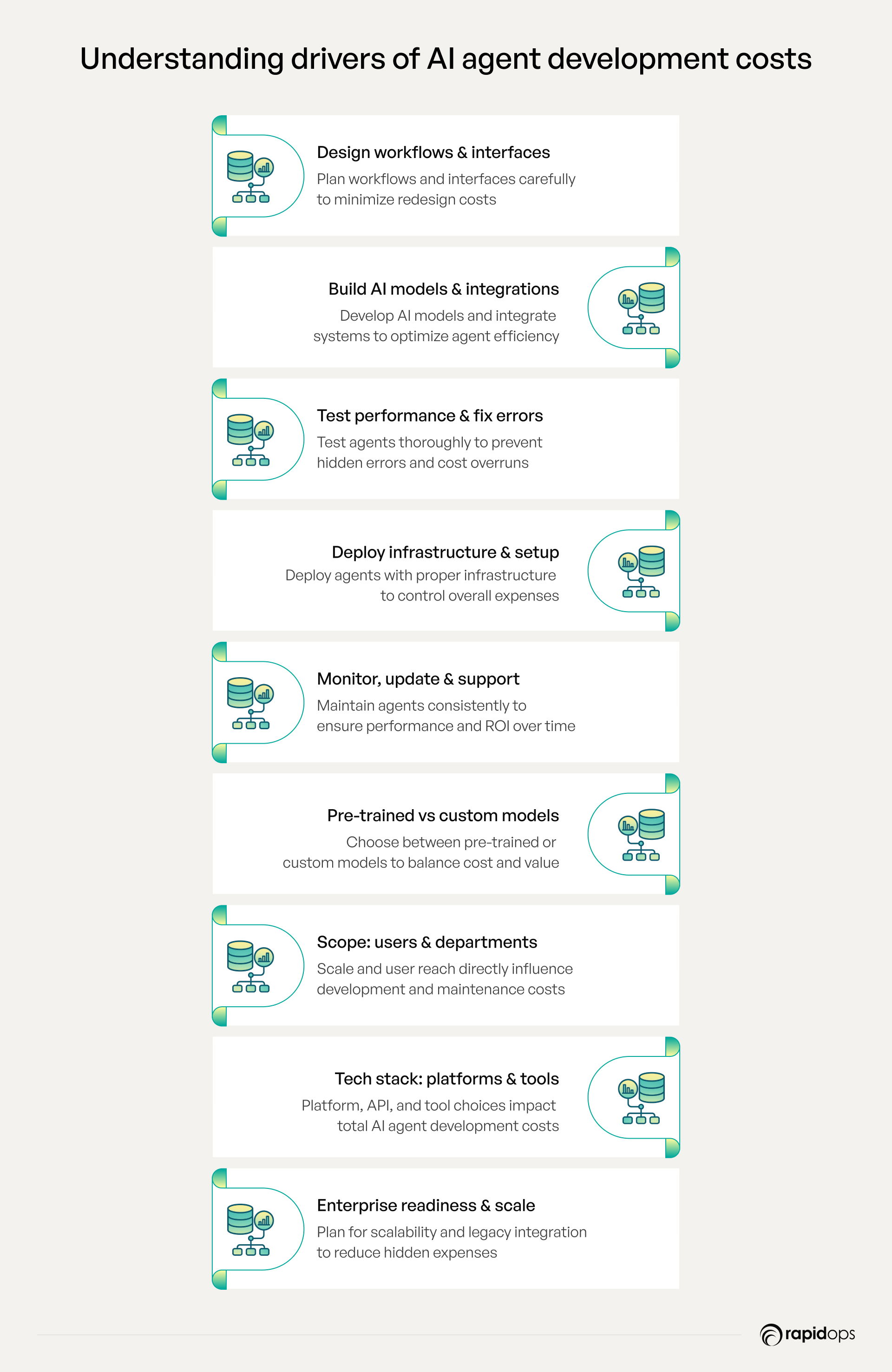
1. Design: Plan workflows & interfaces
The design phase is critical for agent development. It involves mapping workflows, defining user journeys, and creating interface architecture for both end-users and enterprise systems.
Investing in thoughtful design ensures your AI agent delivers measurable business value while minimizing costly redesigns later. Complex UI/UX for conversational agents or multi-system integrations increases both upfront costs and deployment costs, but significantly improves adoption and effectiveness.
2. Development: Build AI models & integrations
The development phase is often the largest driver of AI agent cost. Whether you are using pre-trained AI models, creating a custom AI model, or combining both, extensive coding, algorithm implementation, and AI model development are required.
Advanced AI agents, including autonomous agents and adaptive agents, often rely on machine learning, reinforcement learning, or generative AI. These approaches require significant computational resources, high-quality training data, and the generation of synthetic data for robust performance.
Development complexity directly impacts cost efficiency and operational costs, particularly for multi-agent systems that require inter-agent coordination and the integration of AI systems.
3. Testing: Validate performance & fix errors
Testing ensures your AI agents work reliably in enterprise environments. It includes quality assurance, performance validation, error handling, and scenario testing. Testing complex AI agents or intelligent systems that interact with multiple workflows or departments can reveal hidden dependencies and influence hidden costs. Early testing reduces ongoing costs, improves reliability, and ensures the agent aligns with strategic objectives.
4. Deployment: Rollout & set up infrastructure
Deploying an AI agent extends beyond mere installation. Enterprises must account for infrastructure setup, cloud platforms like Google Cloud AI, API integrations, token usage (for conversational or generative AI agents), and scaling across users and departments.
Whether using agentic AI platforms, pre-trained models, or a custom AI model, deployment costs vary depending on the agent's complexity and the integration with legacy systems. Strategic deployment ensures that your AI agent is operationally ready while controlling upfront expenses and ongoing costs.
5. Maintenance: Monitor, update & support
The total cost of AI agent development extends into ongoing maintenance. This includes monitoring agent performance, updating AI models, refining workflows based on user feedback, and ensuring compliance with governance and data privacy standards. Ongoing maintenance is especially critical for learning/adaptive agents, as well as autonomous agents, where continuous improvement and model retraining are required. These costs ensure long-term ROI and cost savings while maintaining measurable business value.
6. AI model complexity: Pre-trained vs custom
The choice between pre-trained AI models and custom AI models has a significant impact on agent development costs. Pre-trained models accelerate building AI agents, reduce upfront costs, and simplify deployment but may limit customization. Conversely, custom AI models increase development costs and computational resources but allow enterprises to tailor AI agents to specific complex tasks, unique workflows, or proprietary data.
7. Scope: Users, departments & use cases
The costs of AI agents are influenced by scale. A small deployment for a single team or workflow incurs lower AI agent development costs, while enterprise-wide rollouts across departments or global operations increase operational costs and ongoing maintenance. Understanding the scope upfront helps forecast agent development costs accurately and plan cost savings strategies.
8. Technology stack: platforms, APIs & tools
Your AI system's choice of cloud-native platforms, open-source frameworks, or enterprise-grade AI development tools impacts both upfront expenses and ongoing costs. Integration with existing systems, use of APIs, compute costs, and reliance on pre-trained AI models all contribute to agent development costs. Selecting the right stack ensures cost efficiency and maximizes measurable business value.
9. Enterprise readiness: Scalability & legacy integration
Lastly, enterprise readiness determines the feasibility and cost of implementing AI agents at scale. Agents must integrate with legacy systems, adhere to governance frameworks, and support digital transformation initiatives. Enterprises that plan for scalability upfront can reduce hidden costs, optimize AI agent development costs, and ensure the AI agent delivers measurable business value long-term.
By grasping the key factors that influence AI agent development costs, you can anticipate complexity, manage hidden costs, and align resources effectively. Thoughtful planning across design, development, integration, and maintenance ensures your AI initiatives deliver cost-efficient, scalable, and measurable value, transforming potential into real enterprise advantage.
How to approach AI agent development
Selecting the right approach for AI agent development is critical to achieving measurable business value. Your choice impacts functionality, scalability, timelines, ROI, and operational efficiency. By understanding the types of AI agents, enterprise decision-makers can tailor their development strategies. This includes building an AI agent fully in-house, leveraging pre-built tools, partnering with AI development services providers, or deploying agentic AI platforms, while also managing hidden costs, ongoing maintenance, and operational expenses.
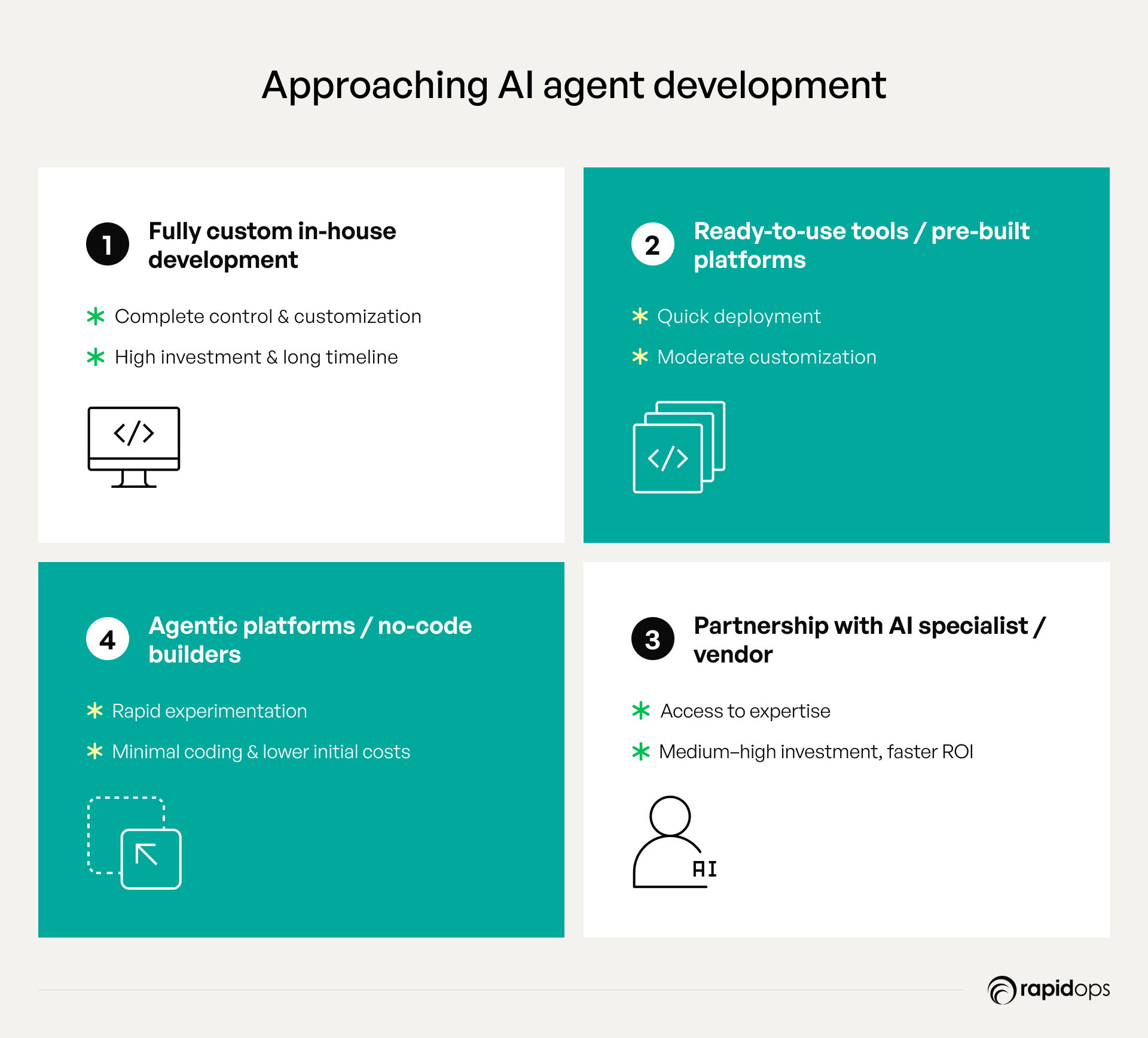
1. Fully custom in-house development
Fully custom in-house development means building an AI agent entirely from scratch, giving enterprises complete control over architecture, model design, workflows, and system integration. This approach is best suited for organizations with unique operational needs, advanced AI/NLP workflows, or generative AI requirements that demand precision and high customization.
Strategic advantages
- Total control over AI decision-making, workflows, and data handling
- Ownership of intellectual property and proprietary AI models
- Flexibility to scale and optimize AI agents across departments
- Seamless integration with legacy systems and enterprise platforms
Why is this the most investment-intensive approach
Fully custom in-house development requires a substantial upfront investment, making it the most expensive among all AI development approaches. Key cost drivers include:
- AI/ML model development: Building, training, and validating custom models, including generative AI, NLP pipelines, and machine learning algorithms, requires significant engineering effort and computational resources.
- Data preparation and infrastructure: High-quality data collection, cleaning, labeling, and building pipelines for continuous learning significantly increase both time and cost.
- Compute and cloud resources: GPUs, TPUs, or scalable cloud solutions are essential for training large models and maintaining high-performance AI operations.
- Talent and expertise: Retaining data scientists, ML engineers, NLP specialists, and DevOps professionals represents a major investment.
- Integration and operational overhead: Ensuring interoperability with existing enterprise systems, orchestrating workflows, and implementing governance frameworks adds complexity and cost.
- Ongoing maintenance: Continuous retraining, performance monitoring, and updates are essential for long-term reliability, accuracy, and compliance.
Implications for budgeting
Enterprises choosing fully custom in-house development must plan for significant upfront spending and extended timelines before realizing ROI. While the investment is high, it offers unmatched customization, control, and strategic alignment, along with potential long-term savings by avoiding recurring platform fees. However, organizations must anticipate the significant initial outlay and operational commitment to ensure the successful deployment and sustainable performance of their AI agents.
2. Ready-to-use tools / pre-built platforms
Pre-built platforms and ready-to-use tools provide basic AI agents or specialized functionalities that are partially trained for enterprise deployment. These solutions reduce the need for extensive training data and computational resources, enabling organizations to rapidly experiment with AI capabilities.
How ready-made platforms can help you deploy faster
- Quick rollout for pilot projects or MVPs
- Moderate customization for agent solutions
- Ability to integrate with existing systems and AI models without heavy development efforts
Limitations and integration issues to consider
- Limited support for complex AI agents or multi-agent systems
- Platform-specific constraints on scalability and feature expansion
- Potential API costs or integration challenges with legacy systems
Understanding licensing and deployment costs
Ready-to-use tools lower upfront costs compared to in-house builds, but recurring licensing fees, platform-specific deployment costs, and potential scaling expenses must be accounted for. Operational costs and ongoing maintenance are shared with platform vendors, which can improve cost efficiency but reduce control.
3. Partnership with an AI agent specialist/custom solution provider
Partnering with an AI agent specialist or custom solution provider allows enterprises to access advanced expertise in agentic AI, reinforcement learning, and intelligent systems without building everything in-house. Vendors bring proven methodologies, frameworks, and operational experience to efficiently deliver complex AI agents, from training models to deploying NLP and machine learning pipelines.
Strategic advantages and ROI potential
- Rapid deployment: Pre-established processes and frameworks shorten development timelines, enabling faster realization of business impact.
- Predictable budgeting: Vendor partnerships often come with SLA-defined costs, making financial planning more transparent and predictable.
- Reduced internal overhead: Enterprises can leverage external talent while minimizing the need for large internal AI teams.
- High ROI potential: Although the upfront investment is medium to high, enterprises recover costs quickly due to accelerated deployment, operational efficiency gains, and early business value.
Considerations for budgeting and operations
- While partnering reduces the internal development burden, enterprises must factor in the costs associated with model customization, data preparation, and integration with their existing enterprise systems.
- Some dependency on the vendor is inevitable for scaling, maintenance, and continuous model updates, but these are offset by faster time-to-value and reduced long-term operational complexity.
- Organizations with moderate to sufficient budgets benefit the most, as the approach maximizes ROI while minimizing internal risk and resource strain.
Cost perspective and value proposition
Vendor partnerships typically involve medium to high costs, depending on the complexity of the agent, the customization of AI models, and the requirements for system integration. However, this approach delivers efficient return on investment because enterprises gain access to ready-to-deploy solutions, reduced trial-and-error costs, and expert guidance, ensuring AI agents deliver measurable business impact faster than fully in-house approaches.
4. Agentic platforms / no-code AI agent builders
No-code agentic AI platforms empower enterprises to quickly build AI agents without extensive programming expertise. These platforms leverage pre-trained models, APIs, and drag-and-drop interfaces to enable experimentation and rapid deployment.
Quick testing and easy deployment with minimal coding
- Rapid iteration of AI agents across web, mobile, chat, or voice
- Low technical barrier for building AI agents
- Early evaluation of functionality and ROI before committing to large-scale deployment
Limits of no-code tools and scaling considerations
- Limited support for advanced AI agents or complex tasks
- Scaling may require additional platform fees or custom development
- Less control over AI model development, compute resources, and operational costs
Cost of starting small and scaling features
Initial costs are low, making agentic platforms ideal for testing and pilot programs. As features scale or complexity increases, costs for training AI models, compute, and operational expenses rise. Organizations must balance cost efficiency with performance, feature requirements, and the long-term development costs of AI agents.
The approach you take in AI agent development determines speed, control, and return on investment. By weighing benefits, challenges, and cost implications across all options, enterprises can build intelligent systems that drive efficiency, innovation, and measurable business growth.
Comparing in-house and outsourced AI agent development
When it comes to developing AI agents, enterprises must make a key choice: handle it internally or rely on external experts. This decision influences how quickly, efficiently, and effectively AI solutions can be deployed to meet business goals. Evaluating the trade-offs upfront is crucial, and the comparison table below highlights the key differences between in-house and outsourced approaches to guide smarter decisions.
| Category | In-house development | Outsourced development | Best for |
| Investment & cost | High upfront costs; long-term control over spend | Lower upfront costs; predictable vendor pricing | Long-term strategic AI initiatives vs quick-start projects |
| Control | Full control over workflows, data, and AI models | Limited control; vendor manages development and updates | Complex/custom AI projects vs standard implementations |
| Flexibility | High flexibility; quick iterations and customization | Moderate flexibility; dependent on vendor capabilities | Rapid innovation cycles vs structured deployment |
| Scalability | Scales internally; requires ongoing investment | Scales predictable; extra fees may apply for expansion | Tailored scaling vs predictable growth |
| Expertise | Requires deep AI/ML and integration skills | Access to vendor expertise reduces internal skill gaps | Developing internal capability vs leveraging external expertise |
| Risk management | Direct management of privacy, compliance, and strategic alignment | Vendor mitigates talent/expertise risk; SLAs critical | Sensitive data & high-risk projects vs lower internal risk |
| Operational efficiency | High potential if internal teams are skilled; requires resources | Efficient deployment via vendor processes; integration may be tricky | Optimized internal operations vs fast operational setup |
| Time to deployment | Longer timelines for hiring, infrastructure, and model development | Faster deployment using vendor experience and pre-built models | Complex, thorough builds vs rapid deployment |
| Long-term ROI | Potentially higher ROI for complex AI projects | ROI depends on vendor efficiency and fees; good for short-term/pilot projects | Strategic, high-impact AI initiatives vs short-term or pilot gains |
Investment and control
In-house development
Building an AI agent internally requires a significant upfront investment, including talent acquisition, infrastructure, AI model development, and training AI models. The payoff is full control over workflows, data, and custom AI models, making it ideal for enterprises targeting complex AI agents, generative AI solutions, or advanced AI agents tailored to unique processes. Control over operational costs and compute resources is maximized, but the organization assumes responsibility for all lifecycle management.
Outsourced development
Outsourcing to an AI development services provider shifts the development burden externally, reducing the need for internal expertise. Costs become more predictable, and deployment timelines are faster. Enterprises benefit from vendor experience in agentic AI development, pre-trained AI models, and complex AI agent design, but they relinquish some control and may face integration challenges with legacy systems or existing AI workflows.
Flexibility and scalability
In-house development
Developing an AI agent internally offers unmatched flexibility. Teams can iterate rapidly on features, scale across multiple departments, and optimize AI agents based on user feedback or operational data. However, scaling requires ongoing investment in training data, model training, and computational resources, which increases agent development costs over time.
Outsourced development
Vendors provide structured solutions that scale predictably but may limit customization or responsiveness to emerging needs. Enterprises can pilot projects quickly, test basic AI agents, or deploy multi-agent systems without long-term internal commitment. Scaling beyond the initial scope may involve additional licensing or service fees, which can impact cost efficiency.
Risk management and expertise
In-house development
Internal teams allow enterprises to directly manage risks, ensure data privacy, and align AI agents with strategic goals. The team must have deep expertise in machine learning, reinforcement learning, agentic AI development, and integration with existing systems to handle complex tasks effectively.
Outsourced development
Vendors mitigate talent and expertise risks by providing ready access to specialized skills. This reduces the internal learning curve but introduces dependency on the vendor for maintenance, updates, and troubleshooting. Enterprises must evaluate SLAs carefully to manage operational expenses and ongoing maintenance.
Decision lens: When to choose each approach
- Choose in-house if your enterprise prioritizes control, custom AI model development, complex or strategic AI initiatives, or long-term cost efficiency.
- Choose outsourcing if your focus is rapid deployment, pilot testing, leveraging external expertise, or minimizing internal talent and infrastructure investment.
By weighing investment, control, scalability, expertise, and operational costs, enterprises can clearly differentiate the value and trade-offs of in-house versus outsourced AI agent development. This insight enables smarter decision-making, optimizes AI agent development costs, and maximizes measurable business value from AI initiatives.
Development lifecycle and cost considerations
Developing AI agents is a strategic investment that extends beyond coding. Every phase of the AI agent development lifecycle impacts the cost, scalability, functionality, and measurable business value of agent development. Understanding each stage helps decision-makers anticipate resource needs, optimize development costs, and manage ongoing maintenance and operational expenses effectively.
Planning and requirement gathering
The first phase sets the foundation for successful AI agent development. It involves identifying enterprise objectives, aligning AI initiatives with business goals, and defining key performance indicators (KPIs). Decision-makers must also assess use cases, determine which complex tasks are suitable for agentic AI, and consider the integration of this technology with existing systems.
Proper data collection and training data preparation are crucial in this context. Early identification of hidden costs, such as data acquisition, token usage, or compute requirements, ensures realistic budgeting and effective allocation of resources for downstream AI model development.
Design and prototyping
Design and prototyping translate business requirements into actionable AI systems. This stage defines user experience (UX), system architecture, workflows, and integration points with legacy systems.
Prototyping enables the testing of pre-trained AI models or custom AI models in controlled environments. Enterprises can explore agentic AI development, validate functional assumptions, and evaluate cost efficiency before committing to full-scale implementation. Early prototyping reduces rework, deployment costs, and operational expenses while informing model training requirements.
Training and model development
This is the most resource-intensive stage. AI model development involves selecting algorithms, building machine learning pipelines, training AI models, and incorporating reinforcement learning where applicable.
Complex AI agents, multi-agent systems, and advanced AI agents require significant computational resources, ongoing monitoring, and robust synthetic data generation. Development costs depend on the scope, AI model complexity, and choice between pre-trained models and fully custom models. Investing in scalable infrastructure here reduces future operational costs and ensures sustainable agent development cost efficiency.
Testing and deployment
Testing validates functionality, performance, and integration. This phase includes quality assurance, user testing, and stress-testing the AI agent across real-world conditions.
Deployment requires scaling infrastructure, integrating APIs, and managing compute costs. Enterprises must plan for ongoing maintenance and establish monitoring frameworks to track agent performance, token usage, and system interoperability. Careful deployment planning ensures measurable business value, reduces errors, and optimizes AI agent cost while minimizing downtime or operational disruptions.
Post-deployment maintenance
AI agent performance evolves over time. Post-deployment maintenance encompasses continuous updates, retraining of AI models, anomaly monitoring, and refining intelligent systems based on user feedback.
Maintenance ensures long-term ROI, cost savings, and alignment with business objectives. Failing to account for ongoing costs, operational expenses, or hidden costs can inflate total agent development cost. Enterprises should establish processes for continuous improvement, ensuring AI solutions remain effective, scalable, and capable of handling increasingly complex tasks.
Every stage of the AI agent development lifecycle, from initial planning to ongoing maintenance, directly influences investment, efficiency, and enterprise impact. Grasping the roles of design, development, testing, and deployment enables smarter cost management and maximizes the value of AI solutions.
Factors affecting ROI beyond development costs
When evaluating AI agent initiatives, true ROI extends far beyond initial development costs. Enterprises that focus solely on building AI agents without considering operational impact, employee adoption, and system scalability often miss the full spectrum of value. Understanding the broader factors that influence ROI empowers decision-makers to make informed choices that enhance both financial and strategic outcomes.
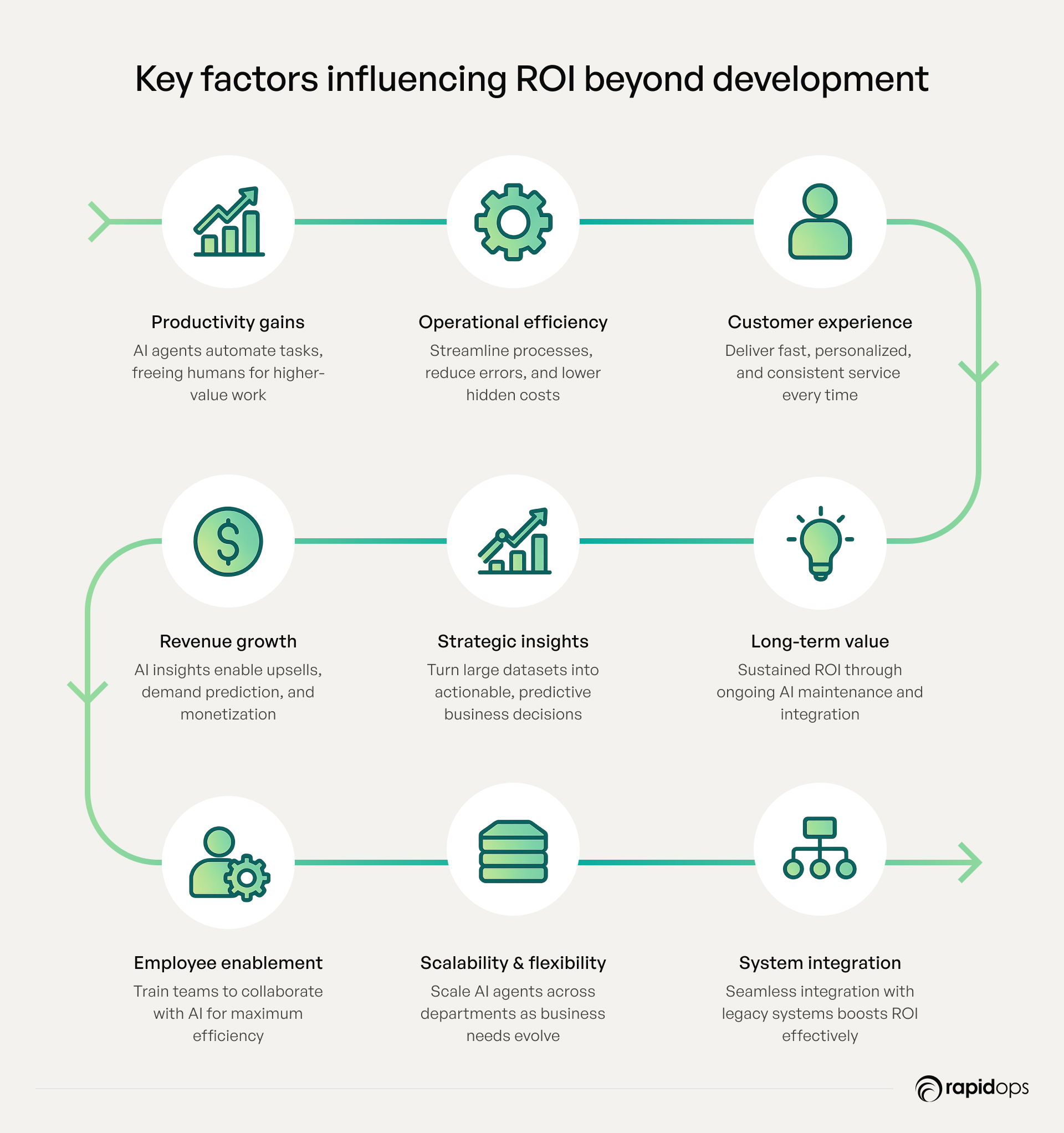
Productivity improvements
AI agents automate repetitive or complex tasks, enabling human agents to focus on higher-value activities. By leveraging machine learning, pre-trained AI models, or custom AI models, organizations can accelerate workflows, reduce time spent on routine processes, and boost overall team productivity. The result is not just cost savings but enhanced capacity for innovation and problem-solving.
Operational efficiency
Beyond automation, intelligent systems streamline enterprise operations. Agentic AI and multi-agent systems optimize resource allocation, reduce operational expenses, and minimize human errors. Integrating AI agents with legacy systems or existing platforms ensures processes run smoothly, providing measurable business value and lowering hidden costs associated with manual interventions.
Enhanced customer experience
AI solutions, such as support agents or intelligent chat systems, enable faster response times and consistent service delivery. By building AI agents that can learn from training data, user feedback, and historical interactions, businesses can deliver personalized experiences that improve customer satisfaction, retention, and long-term loyalty.
Revenue growth potential
AI agents are not just operational tools—they are revenue enablers. From identifying upsell opportunities to predicting demand trends via data collection and model training, enterprises can convert insights from AI systems into actionable strategies that drive revenue. Even agentic AI platforms, when scaled correctly, can unlock new business channels and enhance monetization.
Strategic insights for decision-making
AI agents create intelligent systems that synthesize large datasets, generate predictive analytics, and offer actionable recommendations. This allows leaders to make informed decisions with confidence, uncover strategic opportunities, and refine business strategies based on measurable insights rather than intuition.
Long-term business value
The ROI of AI agents accumulates over time. Properly trained AI models, ongoing maintenance, and thoughtful integration into enterprise workflows contribute to enduring value. By balancing upfront expenses, operational costs, and ongoing investment in agentic AI development, enterprises secure long-term advantages that extend well beyond immediate cost considerations.
Employee enablement and adoption
Successful AI initiatives depend on adoption. Training employees to collaborate with AI agents, leveraging their insights, and integrating them into daily workflows maximizes efficiency. Enterprises that focus on user feedback and iterative improvements create environments where both human and AI agents complement each other, enhancing overall performance.
Scalability and system flexibility
AI solutions must be flexible enough to adapt to the evolving needs of growing enterprises. Pre-trained AI models, custom AI models, or multi-agent systems allow organizations to scale operations without incurring disproportionate costs. The ability to expand AI agent deployment across departments or use cases ensures sustained ROI as business demands evolve.
Integration with existing platforms
Finally, seamless integration with existing systems and workflows is critical. AI agents that can operate alongside legacy systems, leverage data preparation pipelines, and interact with APIs reduce the need for costly infrastructure changes, lower operational expenses, and enhance measurable business value.
Hidden and indirect costs
Building AI agents involves more than upfront development costs. Enterprises often underestimate the hidden and indirect expenses that influence the total cost of AI agent development and long-term ROI. Understanding these costs enables decision-makers to plan effectively, optimize budgets, and avoid unexpected expenses.
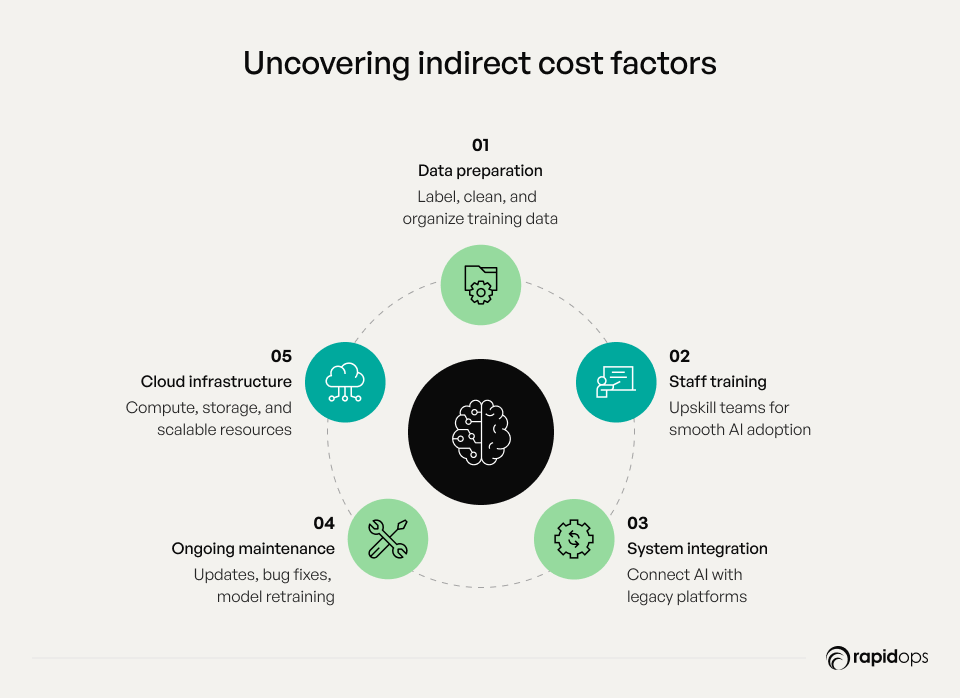
Data preparation and labeling: Time, labor, tools
Quality AI agent development requires extensive data preparation and labeling. This includes curating, cleaning, and annotating training data to ensure it meets accuracy and consistency standards. These efforts require skilled labor, specialized tools, and ongoing supervision, all of which contribute to agent development costs and impact operational expenses.
Training and upskilling staff: Adoption, change management
Successfully deploying AI agents often necessitates training AI models alongside upskilling staff to interact with these systems. Enterprises must invest in human agents, change management, and adoption programs to ensure seamless integration of AI into workflows. These costs, though indirect, influence the overall cost efficiency and measurable business value of AI solutions.
Integration costs: Legacy system adaptation, API development
Integrating AI agents with existing systems often involves developing APIs, utilizing middleware, and adapting to legacy infrastructure. These integration efforts contribute to operational costs and may impact timelines, emphasizing the importance of strategic planning in agent development.
Ongoing maintenance and support: Software updates, bug fixes
AI agent deployment is not a one-time event; it requires ongoing maintenance. Ongoing maintenance, including software updates, bug fixes, model retraining, and performance monitoring, ensures that agentic AI continues to function optimally. Neglecting these indirect costs can undermine ROI and reduce the cost efficiency of AI initiatives.
Cloud and infrastructure costs: Storage, compute, scalability
AI agents rely on scalable infrastructure. Compute costs, cloud storage, and resources required for model training, and pre-trained models contribute to indirect expenses. Enterprises must account for these costs to maintain performance, support multi-agent systems, and optimize agent development cost across the AI lifecycle.
Key success metrics for AI agent investment
Measuring the impact of AI agent initiatives extends far beyond initial development costs. Enterprises that develop their own AI agents as part of a broader digital transformation must track metrics that reflect operational efficiency, strategic value, and customer impact. This ensures every AI agent investment delivers measurable and sustainable ROI while aligning with enterprise objectives.
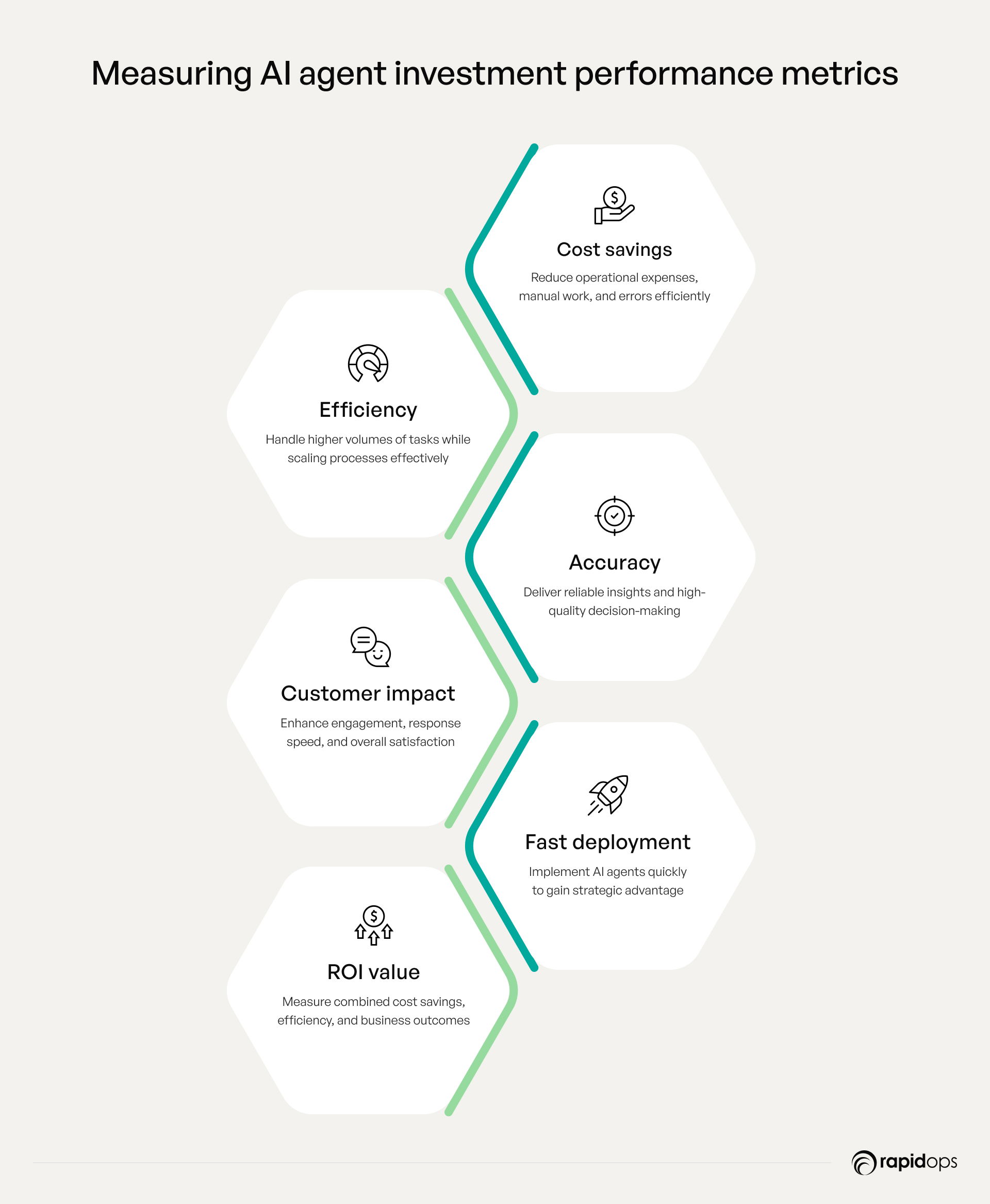
Operational cost reduction
AI agents reduce manual effort, minimize errors, and streamline repetitive processes. By monitoring operational expenses, deployment costs, and compute costs, organizations can quantify tangible cost savings, which directly contribute to ROI and justify continued investment. Understanding hidden fees and the upfront expenses of building AI agents also helps enterprises make informed decisions about future agentic AI development initiatives.
Efficiency and volume handled
AI agents enable higher throughput, managing complex tasks and workflows at scale. Tracking productivity improvements, task volumes, and the capacity of pre-trained AI models or multi-agent systems highlights efficiency gains. These metrics help enterprises assess how AI adoption accelerates processes, optimizes resource utilization, and reduces reliance on human agents, ultimately contributing to cost efficiency and operational excellence.
Accuracy and decision quality
Reliable AI outputs enhance decision-making and mitigate risk. Measuring accuracy, prediction quality, and decision consistency demonstrates the reliability of AI agents and the broader intelligent systems they support. Incorporating techniques such as reinforcement learning or leveraging large language models can further improve outputs. High-quality performance reinforces ROI by reducing errors, improving outcomes, and increasing confidence in enterprise-wide AI solutions.
Customer experience and engagement
AI agents impact the customer journey by delivering faster, personalized, and consistent interactions. Tracking support tickets, response times, engagement metrics, and issue resolution rates illustrates real-world business impact. The integration of agent solutions into existing systems allows enterprises to scale personalized experiences efficiently, showing clear links between AI agent deployment and measurable improvements in customer experience.
Time-to-market
The speed at which AI agents transition from concept to deployment has a significant impact on their competitive advantage. Accounting for model training, training data preparation, and integration with legacy systems ensures faster implementation. Shortening time-to-market allows enterprises to capture early operational benefits, demonstrating measurable business value and maximizing ROI.
Comprehensive ROI
ROI is derived from the combined effects of operational cost reduction, efficiency gains, improved accuracy, and an enhanced customer experience. By tracking ongoing costs, upfront costs, and the performance of agentic AI, leaders gain a holistic understanding of AI value. This enables informed prioritization of AI initiatives and strategic resource allocation while considering both hidden costs and long-term benefits.
Monitoring and continuous Improvement
Consistent measurement of these metrics informs budget planning, agent optimization, and strategic scaling. Continuous evaluation ensures AI agents remain effective, adaptable, and aligned with enterprise goals. Leveraging pre-trained, custom, and open-source AI models for ongoing improvements reinforces the business case, secures sustainable value, and demonstrates the tangible impact of AI initiatives.
Turning AI agent investment into measurable business impact
Investing in AI agents is a strategic decision that goes beyond curiosity; it requires a clear understanding of development costs, cost drivers, and expected ROI. With the insights provided in this guide, you now have a comprehensive understanding of AI agent types, the factors that influence costs, and how each choice affects long-term business value. By evaluating these elements upfront, you can plan realistic budgets, optimize resources, and ensure every AI agent delivers measurable operational and business impact.
At Rapidops, we’ve been partnering with organizations across industries to design, build, and scale AI agents that address real business challenges. Our experience ensures seamless integration with existing systems, alignment with enterprise goals, and efficient resource utilization. This helps teams boost operational efficiency, elevate customer experiences, and transform AI investments into tangible, sustainable results.
Interested in a detailed projection of AI agent development costs for your business and when your investment can be recovered? Schedule an appointment with one of our AI agent experts to get a comprehensive, tailored assessment and actionable insights.
Frequently Asked Questions
How do AI agent costs differ for cloud-based vs. on-premises deployment?
Cloud-based AI agents typically incur subscription or usage-based costs, including compute, storage, and API fees, allowing for flexible scaling with minimal upfront investment. On-premises deployment requires significant upfront capital for hardware, infrastructure, and maintenance, but can offer greater control, data security, and predictable long-term costs. The choice depends on enterprise priorities for scalability, control, and budget allocation.
What are the risks of underestimating AI agent operational costs?
Underestimating operational costs can lead to budget overruns, delayed ROI, and reduced adoption. Common overlooked expenses include compute resources, ongoing maintenance, model retraining, API usage, and integration with legacy systems. Enterprises must account for these factors in advance to ensure accurate financial planning, sustained performance, and measurable business impact from AI agents.
How does scaling AI agents across departments affect total investment?
Scaling AI agents across multiple departments increases complexity, integration requirements, and operational costs. Enterprises must consider cross-team data management, workflow alignment, and consistent user training. While scaling can amplify ROI by streamlining operations and improving efficiency, careful planning is required to balance upfront costs, deployment complexity, and long-term business value.
How do pre-trained AI models reduce development time and costs?
Pre-trained AI models provide a ready-to-use foundation, reducing the need for extensive data collection and model training. This accelerates development timelines, lowers compute and labor costs, and enables enterprises to focus on customization and fine-tuning for specific business needs. Leveraging pre-trained models ensures faster deployment while maintaining high accuracy and performance.
How can enterprises benchmark AI agent costs against industry standards?
Enterprises can benchmark AI agent costs by analyzing average development, deployment, and maintenance expenses across similar industry peers. Key metrics include compute usage, API costs, model training investment, and operational expenses. External benchmarks, case studies, and vendor pricing guides provide insights to ensure competitive budgeting, informed investment decisions, and optimized ROI.
What are the trade-offs between upfront investment and long-term operational savings?
A higher upfront investment, such as building custom AI agents or deploying on-premises, often reduces long-term operational costs through control over infrastructure, reduced subscription fees, and scalability efficiencies. Lower upfront investments, like cloud-based AI, minimize initial capital but may result in ongoing subscription, compute, and API costs. Enterprises must balance cash flow, scalability needs, and projected ROI to select the optimal approach.

Rahul Chaudhary
Content Writer
With 5 years of experience in AI, software, and digital transformation, I’m passionate about making complex concepts easy to understand and apply. I create content that speaks to business leaders, offering practical, data-driven solutions that help you tackle real challenges and make informed decisions that drive growth.
What’s Inside
- Types of AI agents and their cost factors
- What drives AI agent development costs
- How to approach AI agent development
- Comparing in-house and outsourced AI agent development
- Development lifecycle and cost considerations
- Factors affecting ROI beyond development costs
- Hidden and indirect costs
- Key success metrics for AI agent investment
- Turning AI agent investment into measurable business impact

Let’s build the next big thing!
Share your ideas and vision with us to explore your digital opportunities
Similar Stories
- AI
- 4 Mins
- September 2022

- AI
- 9 Mins
- January 2023


Receive articles like this in your mailbox
Sign up to get weekly insights & inspiration in your inbox.

